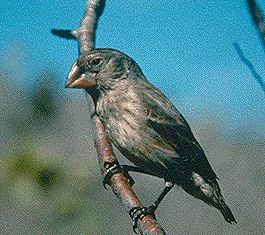Adaptation

Adaptation is the condition of organisms being well designed for life in their environments.
Adaptation refers to all the structural, functional and behavioral characteristics that enhance the organism's reproductive success in its natural environment.
Classic examples include:
• The beak of the woodpecker and the Galapagos finches.
• The almost faultless camouflage of organisms such as stick insects.
Not all evolutionary changes are the result of adaptation. Some are caused by non-adaptive processes such as genetic drift. However, all changes that are the result of adaptation can be explained by natural selection, and the stages in the evolution of the eye provide a good example of this. Adaptations in nature are subject to various constraints.
The image opposite is of the Galapagos finch Geospiza magnirostris, made famous by Darwin; its beak is a classic case of an adaptation.
The exact definition of an adaptation is a very contentious issue in evolutionary biology: John Maynard Smith offers his own view.
How do we recognize adaptations?
How do we find out why natural selection favors particular characters of an organism?
| Next |



